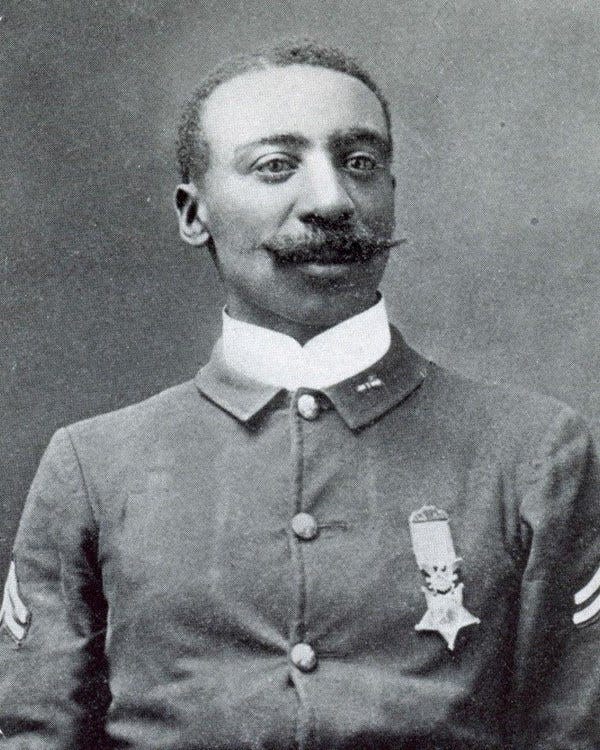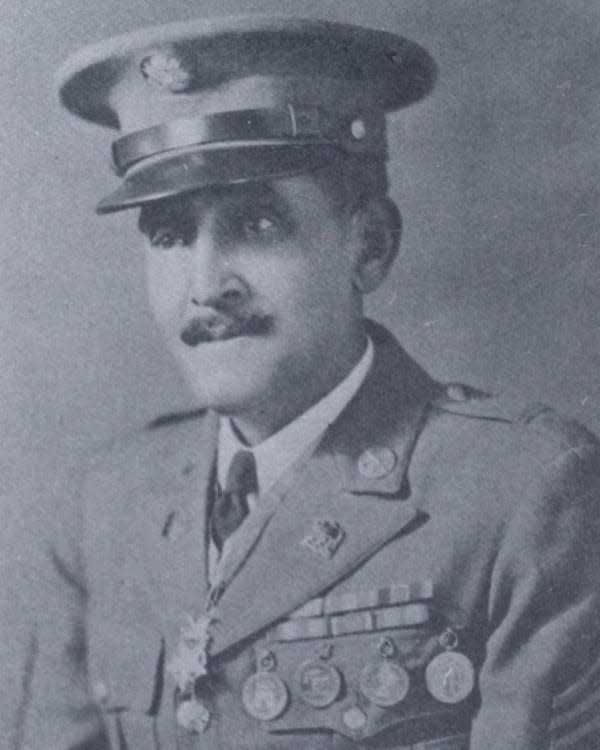Buffalo Soldiers: Paterson men of honor remembered for rescue in Cuba 125 years ago
- Oops!Something went wrong.Please try again later.
Paterson natives and Buffalo Soldiers William Thompkins and George Wanton waded through rifle and artillery fire and each came away with a Congressional Medal of Honor.
The two African American soldiers were part of the U.S. Army's 10th Cavalry and, in 1898, were sent into the Spanish-American War aboard a chartered merchant vessel headed toward Cuba.
The press dispatches that summer provided little hint of their struggle and none of the subsequent heroism that earned them their medals. However, in June 1899, newspaper stories reporting the honor swept the country.
Their mission was so risky that Lt. C.P. Johnson, their commanding officer, later wrote he was very reluctant to risk any men from his contingent of 50. However, he had admittedly run out of options.

"Four expeditions, composed of the Cubans and the immediate friends of the wounded men, had failed because of the extreme danger," Johnson wrote.
Before it ended with U.S. officials seizing Puerto Rico, Guam and the Philippines, the Spanish-American War started to help break Cuba from Spanish domination. Launched in 1898, the war showcased a refreshed and modernized American Navy full of ships with sturdy steel hulls. But they were set among a bunch of chartered transport vessels, such as the one Thompkins and Wanton were aboard that June.
Black History Month:More historic burial grounds for African Americans discovered in New Jersey
The two were with a handpicked unit working directly with Cuban revolutionaries to fight Spanish forces. Their mission under Johnson was one of support, designed to supply guns, ammo and other goods to Cuban fighters on the country's southern shore, according to a contemporary account from Theophilus Gould Steward, a U.S. Army chaplain and Buffalo Soldier. It did not go as planned.

The proposed landing point "was well guarded by Spaniards, who fired upon the landing party," Steward wrote. So, Johnson and his command chose a spot near the mouth of the Tayabacoa River.
The expedition's gunboat USS Peoria made the first incursion, leaving behind the steamship Fanita and the U.S. Army Transport Florida, a chartered boat, Steward wrote. On the afternoon of June 30, the gunship attacked a blockhouse on the shore long enough to land a small force of Cuban and American volunteers from whaleboats. However, an estimated 100 Spanish soldiers lay in wait.
While some Cuban and American soldiers were able to retreat safely to their boats, others — 13 to 16 men, according to the few detailed accounts — were left stranded. One Cuban soldier was killed. Seven more in the attacking force were wounded and forced into hiding, Steward wrote.
Black History Month:How a NY high school student set the record straight for a Black Civil War vet
Though Thompkins and Wanton were born in Paterson, there is no indication they knew each other before joining the Army.

Thompkins, four years Wanton's junior, grew up in Newark. Wanton, meanwhile, remained in Paterson before joining the U.S. Navy in 1884 at age 16. Serving in the Navy until 1888, Wanton left his job as a coachman and his home on 16th Avenue the next year for an assignment in the U.S. Army's 10th Cavalry.
Thompkins also enlisted in the Army in 1889. However, he did so from the Cleveland, Ohio, recruiting station, Army records show.
When the Spanish-American War kicked off, both were Buffalo Soldiers with the 10th Cavalry. Regiments of Black soldiers were given that nickname by Native Americans they encountered while serving mainly on the Western frontier after the Civil War.
Wanton was with Troop M. Thompkins was with Troop G. They nonetheless found themselves together on June 30, 1898, aboard a transport ship near Tunas de Zaza, Cuba.
Four attempts to save the stranded soldiers that day were repulsed, as the Peoria's firepower couldn't compete. But, as dusk hit, five men aboard the Florida volunteered for a fifth attempt under the cover of nightfall. They were George Ahern of New York, Dennis Bell of Washington, D.C., Fitz Lee of Virginia, Thompkins and Wanton. The last four, all African Americans, would receive the Congressional Medal of Honor for voluntarily going "ashore in the face of the enemy and aiding in the rescue of their comrades." Ahern, their superior officer, born in Manhattan to Irish immigrants, was eventually cited for "gallantry in action."
It wasn't until two days later, on July 2, that Johnson's force was able to land and deliver the goods to Gen. Máximo Gómez, Seward wrote.
After the war ended, Wanton returned to Paterson. He briefly lived with his mother before reenlisting in 1902, The News (of Paterson) reported. Another spell as a civilian was followed by a decade in the 10th Cavalry spent everywhere from Vermont to Mexico. He participated in the 1921 ceremonies for the Unknown Soldier before retiring from the military for good four years later, according to a National Park Service account.
Discharged in 1925 as a master sergeant, Wanton returned to Paterson in 1926 to live at 112 16th Ave., The News reported. Thompkins by then had been buried in San Francisco National Cemetery, having died on Sept. 24, 1916. Wanton died in Walter Reed Hospital on Nov. 24, 1940, and was subsequently buried with full military honors at Arlington National Cemetery. Two years later, his Medal of Honor was given to the Passaic County Historical Society. It has at times been on public display in Lambert Castle.
This article originally appeared on NorthJersey.com: Buffalo Soldiers: Paterson NJ men remembered for rescue in Cuba
